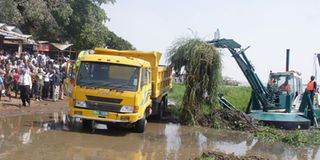Groups turn water hyacinth into cash cow

The water master removes water hyacinth and hippo grass from Lake Victoria. Photo/TOM OTIENO
What you need to know:
- Billions of shillings go down the drain, with organisations engaged in cutthroat competition to get a share of funds meant to rein in the weed that has literally choked life out of the lake
- Paradox as fisherfolk continue to suffer, some organisations have been getting multi-billion shilling contracts
Water hyacinth has turned into a multi-billion cash cow as organisations try to harvest the strangler weed from the world’s second largest fresh water lake. Until April this year, the unwelcome plant had covered 10,000 hectares on the Kenyan side of Lake Victoria.
Some organisations that have conducted research on hyacinth and how it can be contained are the Kenya Marine and Fisheries Research Institute (Kemfri), the Lake Victoria Environmental Management Programme (LVEMP), the Kenya Agricultural Research Institute, Magnam Environmental Network, as well as community-based group, Agulu.
Kemfri senior scientist Reuben Omondi said Lake Victoria has sprung back to life after the hyacinth carpet dried and sunk into the water mass.
“It is important for organisations working on the water master acquired at Sh500 million to be transparent to the public. They should let people know that the hyacinth had sunk long before the machine was acquired,” he said.
The Kisumu County government pledged Sh500 million for removal of hyacinth by first acquiring the water master, which is now operating. The machine was to be operated by LVEMP2 and Kenya Maritime Authority.
“The communities affected want a permanent solution to the problem. We are tired of the hyacinth, which has stifled our livelihood,” said Magnam Environmental Network, a fisherfolks’ lobby group chaired by Mr Mike Nyaguti.
He said the machine is experiencing difficulties crushing hippo grass, its speed is slower than manual removal of hyacinth, and that it does not measure up to the amount of money it was bought.
The weed has choked the livelihoods of fishermen with a potential of harvesting a million tonnes of fish annually worth about Sh56.9 billion. A section of stakeholders, however, see a blessing in the weed because it creates job opportunities and contracts worth millions of shillings.
Osienala, a Kisumu-based NGO launched in 1992 to combat the spread of the weed, has diverted its attention from the plant despite the numerous funds channelled to it by donors.
LVEMP has been at the centre of squabbles pitting other environment stakeholders, who claim that the organisation has been squandering funds meant for hyacinth removal.
Among the first projects on hyacinth was one in 1994 mooted by LVEMP and funded by the World Bank to the tune of Sh6.1 billion to be shared between Kenya, Uganda, and Tanzania. Kenya, through LVEMP, used Sh131.3 million.
The results were not reflected as the five-year programme backfired with the hyacinth spreading to other parts of the lake.
An LVEMP official who asked not to be named because he is not authorised to speak for the entity, told Smart Company that procurement of equipment was bogged down by bureaucracy and mystery. The process was too long, revolving around the Treasury, the Ministry of Environment, and the Central Bank of Kenya.
LVEMP national coordinator Francisca Owuor, when contacted on phone, said she was out of the office.
The livelihoods of fishermen who eke a living from the lake are still threatened since scientists have maintained that hyacinth can only be managed, not eliminated.
“Continuous disposal of industrial waste into the lake has been a challenge to management of hyacinth as it keeps sprouting at an alarming rate,” said Kemfri lead researcher, Dr Oweke Ojwang. A report by the Kenya National Cleaners Production Centre late last year said 90 per cent of regional industries release thousands of tonnes of effluent into the fresh water lake yearly.
Drama has since taken centre-stage in hyacinth removal among stakeholders, with some feeling that they were sidelined from a share of the funds. LVEMP2 is currently in a row with a fishermen’s lobby over alleged mismanagement of funds released for emergency removal of hyacinth.
In 2011, the Ethics and Anti-Corruption Commission launched investigations into the claims. The EACC wrote to the LVEMP programme national coordinator demanding all documents on the project.
The former EACC regional coordinator in Kisumu, Mr David Too, said they expected LVEMP officers to provide documents regarding the procurement services and financial commitments of the project. The case is ongoing.




